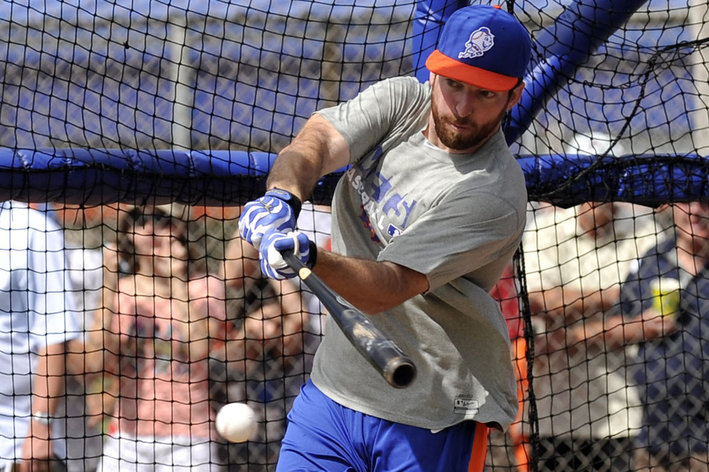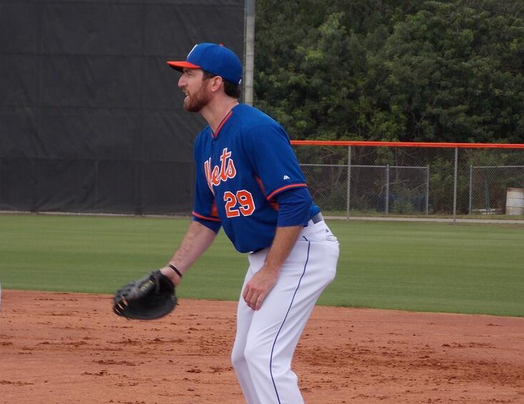 Ike Davis is two seasons removed from his breakout campaign in 2012, where he belted 32 homeruns. It’s such a rare feat in major league baseball to hit 30-plus homeruns that only 5-10% of players do this, on average, any given season. You can’t hit 30 homeruns in a season by accident.
Ike Davis is two seasons removed from his breakout campaign in 2012, where he belted 32 homeruns. It’s such a rare feat in major league baseball to hit 30-plus homeruns that only 5-10% of players do this, on average, any given season. You can’t hit 30 homeruns in a season by accident.
Davis gets a bad rap for his unorthodox swing. You didn’t have to be a hitting coach to see what was wrong with his swing at the beginning of last year—he started with his hands up above his head, then as the pitcher began his motion, he dropped them all the way down to waist level only to have to bring them back up to the hitting zone to take his swing.
Simply stated—Davis’ timing was off. The science of hitting is so precise, that the time that it takes you to blink your eye can turn a would-be homerun, to a weak grounder or even a swing and miss. A millisecond is all it takes to turn a potential All-Star into a player getting run out of town.
He eventually went down to Triple-A to work out the kinks, and came back with a tweaked version of his original swing.
While he still drops his hands, as was evident in the video posted by Adam Rubin of Davis taking batting practice the other day, it’s not as dramatic. He now keeps his hands at about shoulder height in his stance, cutting down the distance he drops his hands. This should allow him to get to the ball quicker.
It’s not the dropping of the hands that is the problem with Davis, it was the distance he was dropping them. Dropping the hands is the way Davis loads his swing, it just looks awkward because most hitters bring their hands straight back. It’s different from the way we were all taught growing up. The only difference is, you and I are sitting on our couch watching him play every week on our television, and he’s a major league baseball player. That means he is in the top five percent of baseball players on the entire planet—that deserves our respect.
Plenty of players have had successful swings with unorthodox swings—Gary Sheffield is the first player that comes to mind, and there are countless others.
After he made the adjustment to his swing down in Triple-A last season, he was hitting much better. Take a look at the splits below:
| Split | G | PA | AB | R | H | 2B | 3B | HR | RBI | SB | CS | BB | SO | |||||
|---|---|---|---|---|---|---|---|---|---|---|---|---|---|---|---|---|---|---|
| 1st Half | 63 | 239 | 212 | 21 | 35 | 3 | 0 | 5 | 18 | 2 | 0 | 25 | 73 | .165 | .255 | .250 | .505 | .222 |
| 2nd Half | 40 | 138 | 105 | 16 | 30 | 11 | 0 | 4 | 15 | 2 | 0 | 32 | 28 | .286 | .449 | .505 | .954 | .351 |
After the adjustment, you can see that Davis really became an offensive threat again. Those second-half numbers are outstanding. He increased his walks and batting average while reducing his strikeouts (and I mean, he really reduced his strikeouts). He had almost as many hits, homers and RBI as he did in the first half of the year but with over 100 fewer at-bats. This turn around was all due to the slight tweak in the distance his hands travelled in his swing—he gained back that millisecond he was losing.
If we apply what he did in the second half of 2013, across a hypothetical 500 at-bats, he would have hit in the .280-range, with 20 homeruns, 100+ walks, and about 40 doubles in 2014. If we were in Boston, we would be saying he hit the ball wicked-hard, but in New York, we want to over-analyze his swing and run him out of town because of it.
If Davis can stay focused, there is enough here to think he can get his career back on track. He shouldn’t be concerned with what the newspaper writers, or anyone else for that matter, thinks about 2013. He has to put 2013 behind him for good, or he will never be able to move on with his career. I will leave you with a quote, from Keven Holmes, which summarizes the mindset hitters have to have at the plate…















